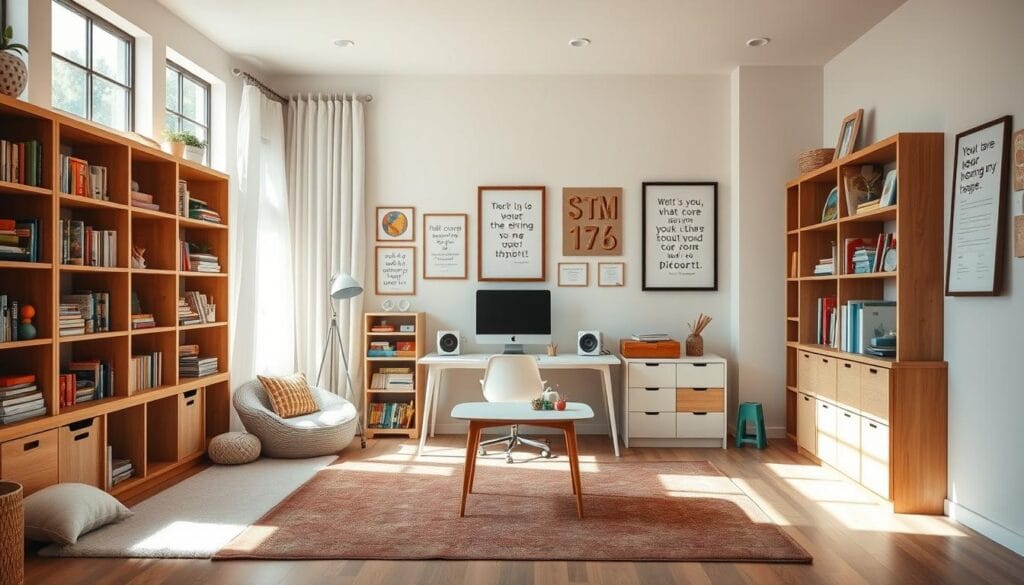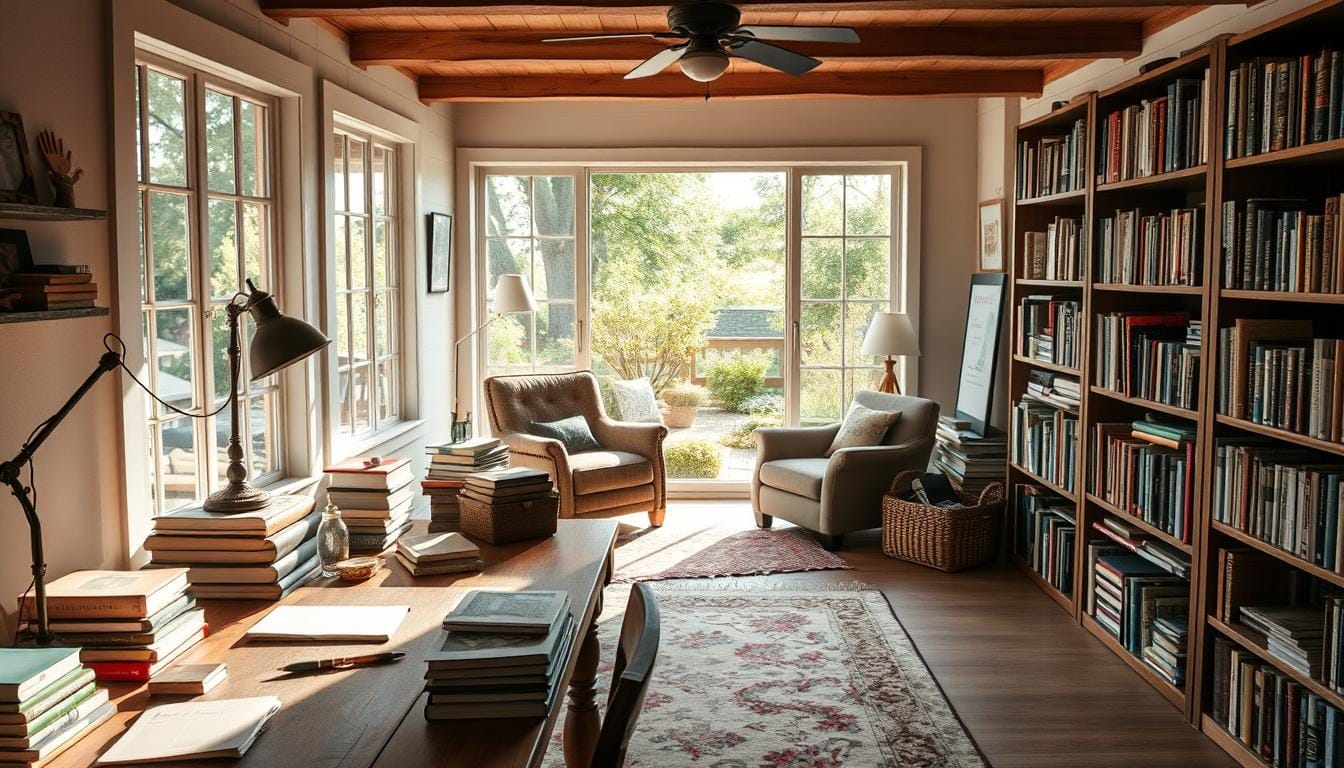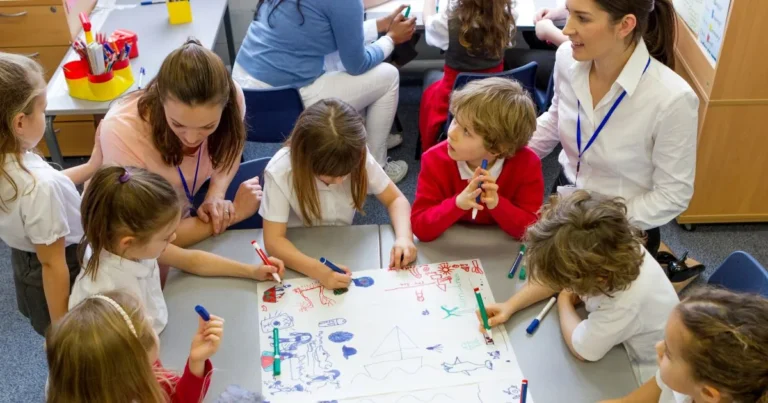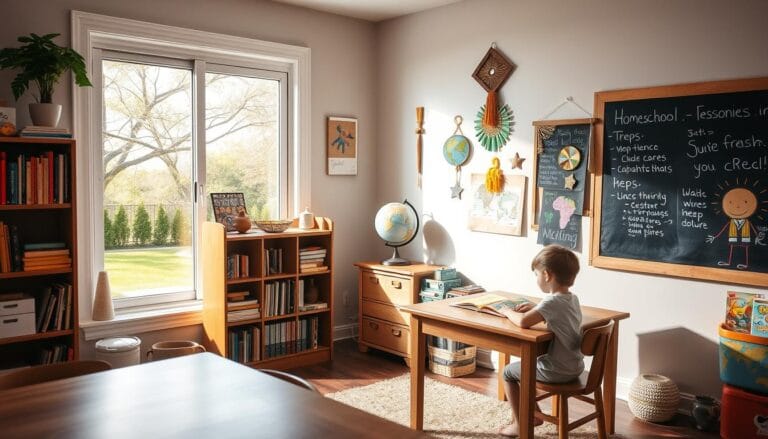Creative Homeschool Room Ideas for Every Space
Imagine turning your home into a lively learning space. It’s not just about making a classroom. It’s about creating a flexible area that makes learning exciting.
Every family’s homeschool room is special. With 90% of homeschooling families having a dedicated area, you can make a space that shows your family’s style. Whether you have a big room or a small corner, you can make it a place of inspiration.
The National Center for Education Statistics shows homeschooling is growing by 7% yearly. This means more families are choosing personalized education. Your homeschool room can be more than a study area. It can be a place where creativity and learning come together.
This guide will show you how to maximize your homeschool room. We’ll cover ideas for space, learning, and making education fun for your family. You’ll learn about storage and design tips to create a space that grows with your kids.
Table of Contents
Understanding the Purpose of a Homeschool Space
Creating a homeschool room layout is more than just setting up a study area. It’s about making a space that supports your family’s learning journey. Even if all learning happens in shared areas, a well-designed space can greatly improve your experience.
A dedicated homeschool area does more than just teach. It turns learning into a flexible, dynamic experience. The aim is to make a space that meets your kids’ changing needs while staying organized and inspiring.
Benefits of a Dedicated Learning Environment
Having a dedicated homeschool room brings many benefits:
- It helps you focus better
- It keeps your learning supplies organized
- It separates learning from playtime
- It lets you create a learning space that feels personal
Breaking Free from Traditional Classroom Setup
Your homeschool room doesn’t have to look like a classroom. About 80% of homeschooling happens on couches or dining tables. This shows that learning can be both comfy and flexible.
“Education is not the filling of a pail, but the lighting of a fire.” – William Butler Yeats
Creating a Balance Between Structure and Flexibility
Good homeschool room layouts mix structure with flexibility. Here are some tips:
- Choose furniture that can change its layout
- Set up different learning areas
- Get storage that grows with your kids
- Use visual tools to stay organized
By designing your homeschool space with care, you’ll create a place that encourages learning, creativity, and growth.
Essential Elements of a Functional Homeschool Room
Creating a great homeschool room needs careful planning. You must pick the right furniture and tools. The right furniture can turn any room into a place where learning happens easily.
Key elements of a functional homeschool space include:
- Flexible work surfaces that fit different learning styles
- Efficient storage for school materials
- Comfortable and ergonomic seating
- Good lighting for studying
When picking out your homeschool room essentials, think about furniture that can grow with your kids. Adjustable desks and modular shelving units are great because they last a long time. Make sure you have storage that keeps things organized but easy to find.
“A well-designed learning space can inspire creativity and enhance educational experiences.”
Don’t stick to traditional classroom layouts. Your homeschool room should show off your family’s learning style. Add cozy reading spots, computer areas, and places for teamwork.
- Use open shelving for things you use a lot
- Implement grab-and-go storage systems
- Choose calming colors that help you focus
- Include acoustic wall tiles for educational displays
You don’t need to spend a lot to make a homeschool room work well. With smart planning and furniture choices, you can make a space that inspires learning and supports your kids’ education.
Smart Storage Solutions for Educational Materials
Starting a homeschool room organization plan means knowing how to handle your learning stuff. Good storage makes your study area neat and fun, helping lessons go smoothly.
Storage isn’t just about hiding things. It’s about making a space that helps you learn and be creative. The right setup keeps your study materials easy to find and tidy.
Organizing Curriculum and Books
Make a book plan that fits your family. Here are some ideas:
- Use modular cube bookcases for all book sizes
- Make a color-coded shelf system for easy finding
- Get adjustable shelves to grow with your studies
Managing Art Supplies and Crafting Materials
Art supplies can get too much without the right setup. Try these ideas:
- Use rolling carts for easy crafting spots
- Try pegboard systems for hanging things
- Sort materials in clear, labeled bins
Storing Technology and Digital Resources
Digital learning needs smart tech storage. Keep your gadgets safe with these tips:
- Have a special spot for charging devices
- Use cable organizers to keep things tidy
- Get protective cases for laptops and tablets
*Tip: Less is more when it comes to storage. Regularly declutter and reassess your organizational systems to keep your homeschool room efficient and inspiring.*
With these tips, you’ll make a learning space that’s both useful and welcoming. It will help your family reach their educational goals.
Adaptable Furniture and Layout Options
Creating a homeschool room that changes with your needs is all about being creative and planning well. About 80% of homeschooling families change their living areas to fit their learning needs. This shows how important it is to have a flexible learning space.
Your homeschool room should have furniture that can change with your family’s needs. Look into these flexible options:
- Modular desks with adjustable heights
- Wheeled storage units for easy reconfiguration
- Convertible tables that transform for different activities
- Stackable chairs for space-saving flexibility
“The best homeschool spaces evolve with your children’s learning needs” – Experienced Homeschool Parent
Interestingly, 70% of homeschoolers say a dedicated room isn’t necessary for learning. What’s most important is smart organization and the right furniture placement. Set up different learning areas in your space, like:
- Quiet reading corner
- Collaborative workspace
- Art and craft station
- Technology learning area
When picking out homeschool room furniture, choose very useful pieces. Invest in furniture that can adapt to multiple learning styles and ages. This way, your space will stay useful and inspiring for a long time.
Homeschool Room Ideas for Small Spaces
Turning small areas into learning spaces is tough for homeschooling families. With 42% of homeschooling families using shared living spaces, creative solutions are key. They help make educational environments work better.
You don’t need a big space for your homeschool room. 75% of homeschoolers manage their stuff well in small areas. They use smart strategies to do it.
Maximizing Vertical Storage
Vertical storage is a smart way to use space in your homeschool room. Here are some tips:
- Install wall-mounted shelves to use unused wall space
- Use hanging organizers for your curriculum and supplies
- Put up higher shelving to keep things out of reach of little kids
Multi-functional Furniture Solutions
Smart furniture can change your learning space without making it cluttered. Look for furniture that does more than one thing:
- Fold-down desks that you can fold up when not in use
- Storage ottomans for both sitting and storing things
- Nesting tables that can be moved and stored easily
Creating Learning Zones in Limited Areas
Make specific areas in shared spaces for learning. About 60% of families using multi-functional spaces say it doesn’t mess up their daily life.
85% of homeschooling success comes from keeping things organized, not the size of the space.
Using these homeschool room ideas can make your learning space efficient and fun. You can do it, no matter how much space you have.
Creating an Inspiring Learning Environment

Turning your homeschool room into a place of inspiration is more than just decorating. It’s about creating a space that sparks curiosity and motivates learning. It should also be functional and able to change as your children grow.
Here are some important tips for making your homeschool room engaging:
- Display educational artwork that doubles as learning tools
- Use color psychology to create energizing yet calming spaces
- Incorporate interactive learning walls
- Personalize the environment with your family’s unique interests
“An inspiring learning environment is the canvas where educational dreams take shape.” – Educational Design Expert
Recent studies show how crucial a well-designed learning space is. A 2024 review found that flexible educational environments greatly improve children’s learning.
When designing your homeschool room, focus on elements that:
Stimulate creativity
Support individual learning styles
Provide practical storage solutions
Your homeschool room should grow with your children’s learning. Keep updating and changing the space to keep it inspiring and useful.
Age-Appropriate Design Considerations
Creating a homeschool room needs careful thought about your kids’ growth stages. Your room layout should change as your kids grow. This helps meet their learning needs and keeps them engaged in learning.
Each age group needs its homeschool room ideas. These ideas should match their learning styles and growth needs.
Early Learning Setup (Ages 4-8)
Young learners aged 4-8 need a room that encourages play and hands-on learning. Studies show that screen learning sticks in our minds for just 4%. So, interactive and touch-based learning is key.
- Create vibrant, accessible spaces with low shelves
- Include interactive learning stations
- Use adjustable-height desks
- Incorporate colorful storage solutions
Middle Years Configuration (Ages 9-13)
Middle schoolers need a room that supports teamwork and solo research. They also use technology more for learning.
- Design collaborative workspace areas
- Provide dedicated technology zones
- Include organizational tools like whiteboards
- Create flexible seating arrangements
High School Study Space (Ages 14-18)
High school homeschool rooms should help students become independent. They need to be ready for future academic challenges. Ergonomic design is important for long study hours.
- Install spacious work surfaces
- Invest in ergonomic chairs
- Add built-in charging stations
- Create personalized study nooks
The key to an effective homeschool room is flexibility and adaptability to meet your children’s changing educational needs.
Budget-Friendly Room Transformation Tips

Creating an inspiring homeschool room doesn’t have to cost a lot. With smart strategies, you can make a learning space that’s both useful and affordable. Studies show families spend only $250-$500 to turn their homeschool room ideas into reality.
Here are some budget-friendly tips for your homeschool room decor:
- Explore Facebook Marketplace for second-hand furniture
- Visit thrift stores for unique educational decorations
- Leverage DIY projects to customize your space
- Repurpose existing furniture with creative paint techniques
“Creativity trumps cost when designing a learning environment” – Homeschool Parent Network
Online resources can help save money. Free printable educational materials and digital learning tools can make your homeschool room better without extra cost. About 35% of homeschoolers now use online platforms to add to their curriculum.
Tools like pegboards and storage bins can make your space better. Parents say using smart storage solutions cuts daily clutter by 30%. A well-designed homeschool room doesn’t need to be expensive. It just needs careful planning and creativity.
- Use vertical storage to maximize space
- Select multi-functional furniture
- Incorporate budget-friendly organizational systems
Your homeschool room can be both inspiring and affordable with these smart tips.
Conclusion
Creating a homeschool room is more than just setting up furniture. It’s about making a space that sparks curiosity and helps with learning. Your room should show your family’s learning style and grow with your needs. With good planning and creative organization, any space can become a place of learning.
Studies show 90% of homeschooling families use a mix of learning methods. So, your room should be flexible and change as needed. Think about using waterproof floors and furniture that can grow with your kids. The best rooms balance order and creativity, for both studying and exploring.
Your homeschool room will change over time. Begin with the essentials: a comfy spot, good light, and smart storage. Be ready to make changes as your kids’ learning needs shift. By putting thought into your room, you’ll make a place that supports learning and inspires a love for it.
Whether you have a big room or a small corner, the goal is to make it work for your family. Stay open to change, be creative, and enjoy learning together.








